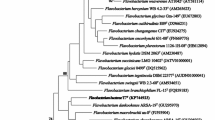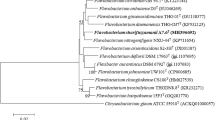Abstract
A flexirubin-type yellow-pigmented, non-gliding, non-flagellated, gram-negative bacterium strain, designated F3T, was isolated from a drilling core sample of the Qiangtang basin, Qinghai-Tibetan plateau, China. Phylogenetic analysis based on 16S rRNA gene sequences showed that the strain F3T belongs to the genus Flavobacterium, with the highest 16S rRNA gene sequence similarity to the Flavobacterium noncentrifugens CGMCC 1.10076T (94.92 %). Strain F3T grew optimally at temperature about 20 °C, at pH about 7.0–8.0, at NaCl concentration 0 % (w/v). The DNA G+C content of the isolate was 35.5 mol%. The major polar lipid was phosphatidylethanolamine, predominant cellular fatty acids of the strain was iso-C15:0 (22.02 %), while the major menaquinone was menaquinone 6. Due to the phenotypic and genetic distinctiveness and several other characteristic studied in this article, we consider F3T as a novel species of the genus Flavobacterium, and propose to name it Flavobacterium qiangtangensis sp. nov. The type strain is F3T (=CGMCC 1.12706T = JCM 19739T).


Similar content being viewed by others
References
Ali Z, Cousin S, Fruhling A et al (2009) Flavobacterium rivuli sp. nov., Flavobacterium subsaxonicum sp. nov., Flavobacterium swingsii sp. nov. and Flavobacterium reichenbachii sp. nov., isolated from a hard water rivulet. Int J Syst Evol Microbiol 59:2610–2617
Aslam Z, Im WT, Kim MK et al (2005) Flavobacterium granuli sp. nov., isolated from granules used in a wastewater treatment plant. Int J Syst Evol Microbiol 55:747–751
Bergey DH, Harrison FC, Breed RS, Hammer BW, Huntoon FME (1923) Bergey’s manual of determinative bacteriology. Williams & Wilkins, Baltimore
Bernardet J-F, Segers P, Vancanneyt M et al (1996) Cutting a Gordian knot: emended classification and description of the genus Flavobacterium, emended description of the family Flavobacteriaceae, and proposal of Flavobacterium hydatis nom. nov. (basonym, Cytophaga aquatilis Strohl and Tait 1978). Int J Syst Bacteriol 46:128–148
Bernardet JF (2002) Proposed minimal standards for describing new taxa of the family Flavobacteriaceae and emended description of the family. Int J Syst Evol Microbiol 52:1049–1070
Bligh EG, Dyer WJ (1959) A rapid method of total lipid extraction and purification. Can J Biochem Physiol 37:911–917
Bowman JP (2000) Description of Cellulophaga algicola sp. nov., isolated from the surfaces of Antarctic algae, and reclassification of Cytophaga uliginosa (ZoBell and Upham 1944) Reichenbach 1989 as Cellulophaga uliginosa comb. nov. Int J Syst Evol Microbiol 50(5):1861–1868
Chun J, Lee JH, Jung Y et al (2007) EzTaxon: a web-based tool for the identification of prokaryotes based on 16S ribosomal RNA gene sequences. Int J Syst Evol Microbiol 57:2259–2261
Collins M (1985) Analysis of isoprenoid quinones. Methods Microbiol 18:329–366
Collins M, Goodfellow M, Minnikin D (1980) Fatty acid, isoprenoid quinone and polar lipid composition in the classification of Curtobacterium and related taxa. J Gen Microbiol 118:29–37
Cowan ST, Steel KJ, Barrow G et al (2004) Cowan and Steel’s manual for the identification of medical bacteria. Cambridge University Press, Cambridge
Dong K, Xu B, Zhu F et al (2013) Flavobacterium hauense sp. nov., isolated from soil and emended descriptions of Flavobacterium subsaxonicum, Flavobacterium beibuense and Flavobacterium rivuli. Int J Syst Evol Microbiol 63:3237–3242
Gerhardt P, Wood WA, Krieg NR (1994) Methods for general and molecular bacteriology. American Society for Microbiology, Washington
Gounot A-M (1986) Psychrophilic and psychrotrophic microorganisms. Experientia 42:1192–1197
Krieg NR, Padgett PJ (2011) Phenotypic and physiological characterization methods. In: Fred R, Aharon O (eds) Methods in microbiology. Academic Press, Waltham, pp 15–60
Leifson E (1951) Staining, shape, and arrangement of bacterial flagella. J Bacteriol 62:377
Lim CS, Oh YS, Lee JK et al (2011) Flavobacterium chungbukense sp. nov., isolated from soil. Int J Syst Evol Microbiol 61:2734–2739
Mesbah M, Premachandran U, Whitman WB (1989) Precise measurement of the G+C content of deoxyribonucleic acid by high-performance liquid chromatography. Int J Syst Bacteriol 39:159–167
Minnikin D, Collins M, Goodfellow M (1979) Fatty acid and polar lipid composition in the classification of Cellulomonas, Oerskovia and related taxa. J Appl Microbiol 47:87–95
Minnikin DE, O’donnell AG, Goodfellow M et al (1984) An integrated procedure for the extraction of bacterial isoprenoid quinones and polar lipids. J Microbiol Methods 2:233–241
Morita RY (1975) Psychrophilic bacteria. Bacteriol Rev 39:144
Odumeru JA, D’amore T, Russell I et al (1993) Alterations in fatty acid composition and trehalose concentration of saccharomyces brewing strains in response to heat and ethanol shock. J Ind Microbiol 11:113–119
Sasser M (1990) Identification of bacteria by gas chromatography of cellular fatty acids
Steven B, Briggs G, Mckay CP et al (2007) Characterization of the microbial diversity in a permafrost sample from the Canadian high Arctic using culture-dependent and culture-independent methods. FEMS Microbiol Ecol 59:513–523
Tamura K, Peterson D, Peterson N et al (2011) MEGA5: molecular evolutionary genetics analysis using maximum likelihood, evolutionary distance, and maximum parsimony methods. Mol Biol Evol 28:2731–2739
Tindall BJ, Rossello-Mora R, Busse HJ et al (2010) Notes on the characterization of prokaryote strains for taxonomic purposes. Int J Syst Evol Microbiol 60:249–266
Van Trappen S (2003) Flavobacterium gelidilacus sp. nov., isolated from microbial mats in Antarctic lakes. Int J Syst Evol Microbiol 53:1241–1245
Wilhelm RC, Niederberger TD, Greer C et al (2011) Microbial diversity of active layer and permafrost in an acidic wetland from the Canadian high arctic. Can J Microbiol 57:303–315
Yi H, Oh HM, Lee JH et al (2005) Flavobacterium antarcticum sp. nov., a novel psychrotolerant bacterium isolated from the Antarctic. Int J Syst Evol Microbiol 55:637–641
Yoon JH, Park S, Kang SJ et al (2010) Flavobacterium ponti sp. nov., isolated from seawater. Int J Syst Evol Microbiol 61:81–85
Zhang G, Ma X, Niu F et al (2007) Diversity and distribution of alkaliphilic psychrotolerant bacteria in the Qinghai-Tibet Plateau permafrost region. Extremophiles 11:415–424
Zhu L, Liu Q, Liu H et al (2013) Flavobacterium noncentrifugens sp. nov., a psychrotolerant bacterium isolated from glacier meltwater. Int J Syst Evol Microbiol 63:2032–2037
Acknowledgments
The work was supported by the National Special Research Fund (Gas Hydrate Resource Exploration and Production Testing Project. Grant No.: GZHL20110308, GZHL20110323), we thanks the identification service of the China General Microbiological Culture Collection Center (CGMCC) for their help.
Author information
Authors and Affiliations
Corresponding author
Additional information
The GenBank/EMBL/DDBJ accession number for the 16S rRNA gene sequence of strain F3T is KF726983.
Rights and permissions
About this article
Cite this article
Huang, F., Zhang, Y., Zhu, Y. et al. Flavobacterium qiangtangensis sp. nov., Isolated from Qiangtang Basin in Qinghai-Tibetan Plateau, China. Curr Microbiol 69, 234–239 (2014). https://doi.org/10.1007/s00284-014-0579-7
Received:
Accepted:
Published:
Issue Date:
DOI: https://doi.org/10.1007/s00284-014-0579-7




